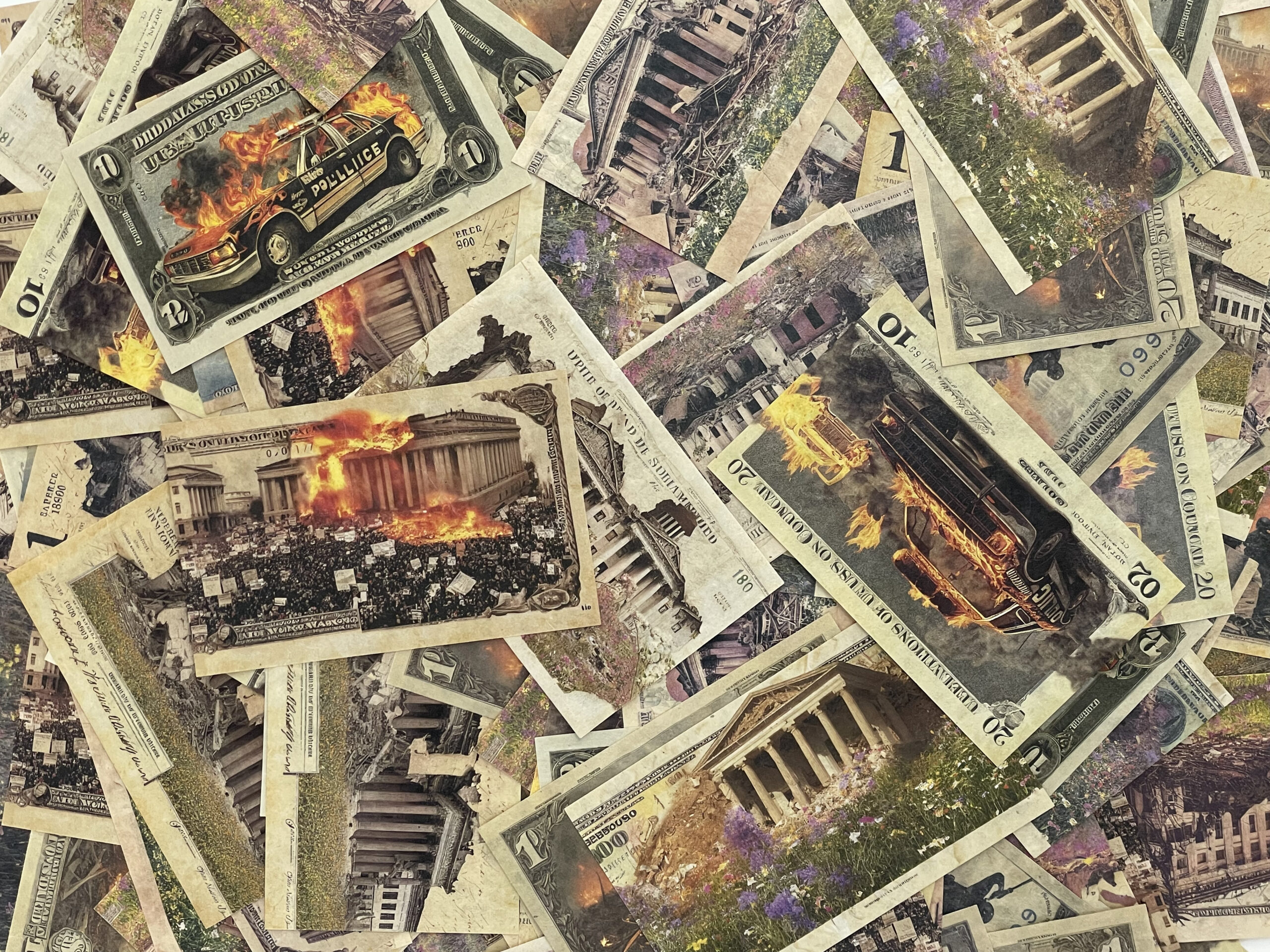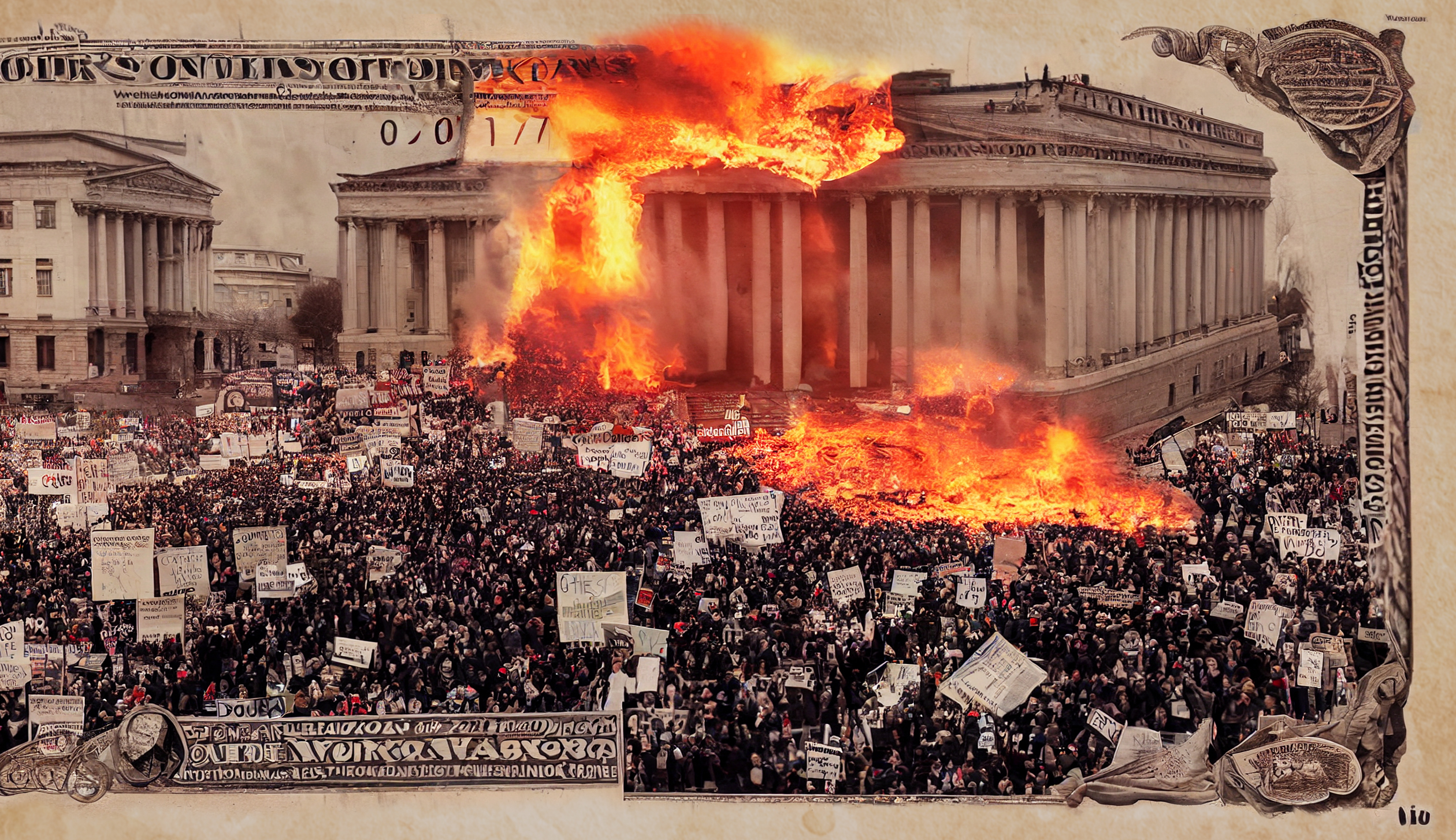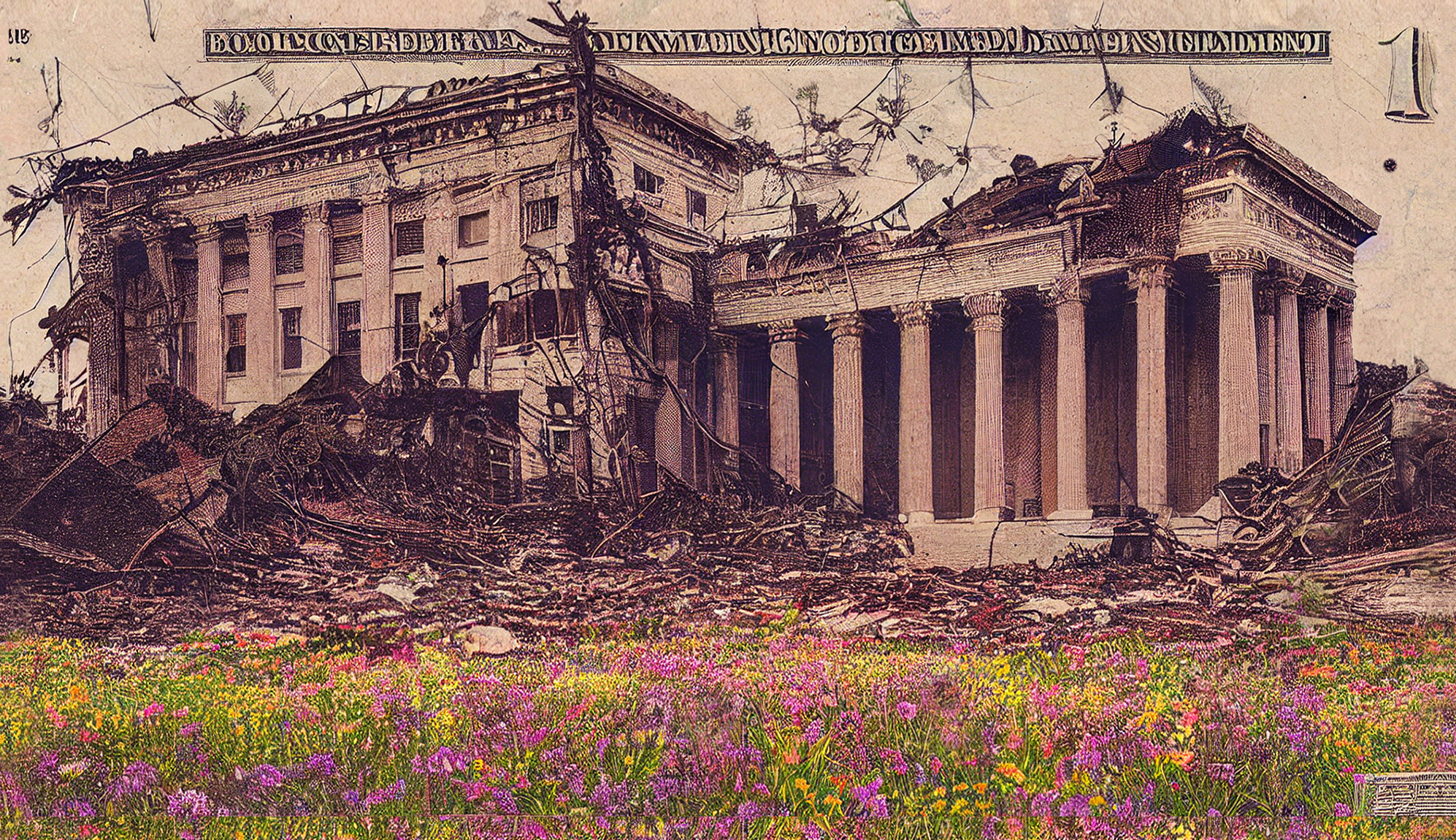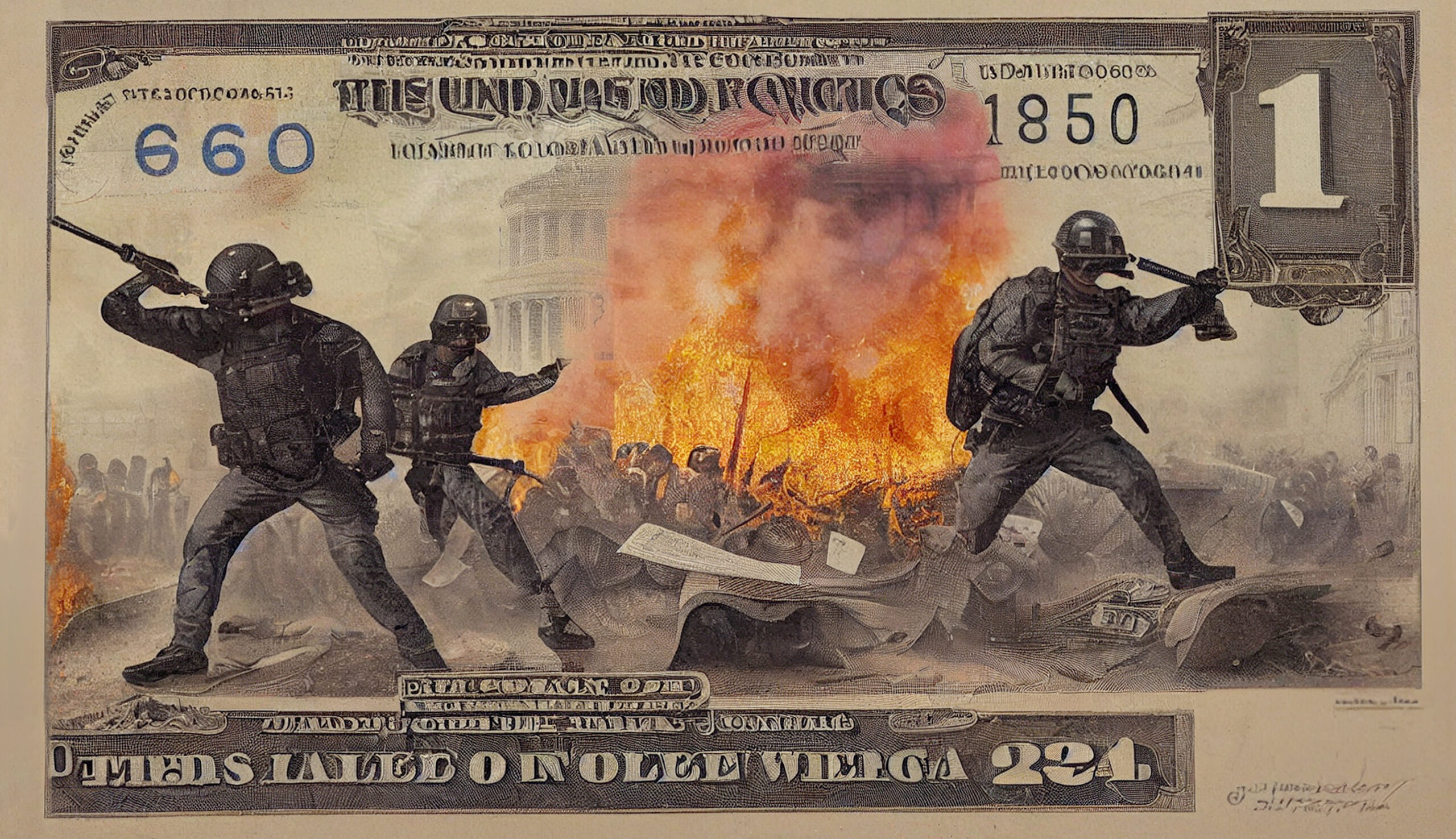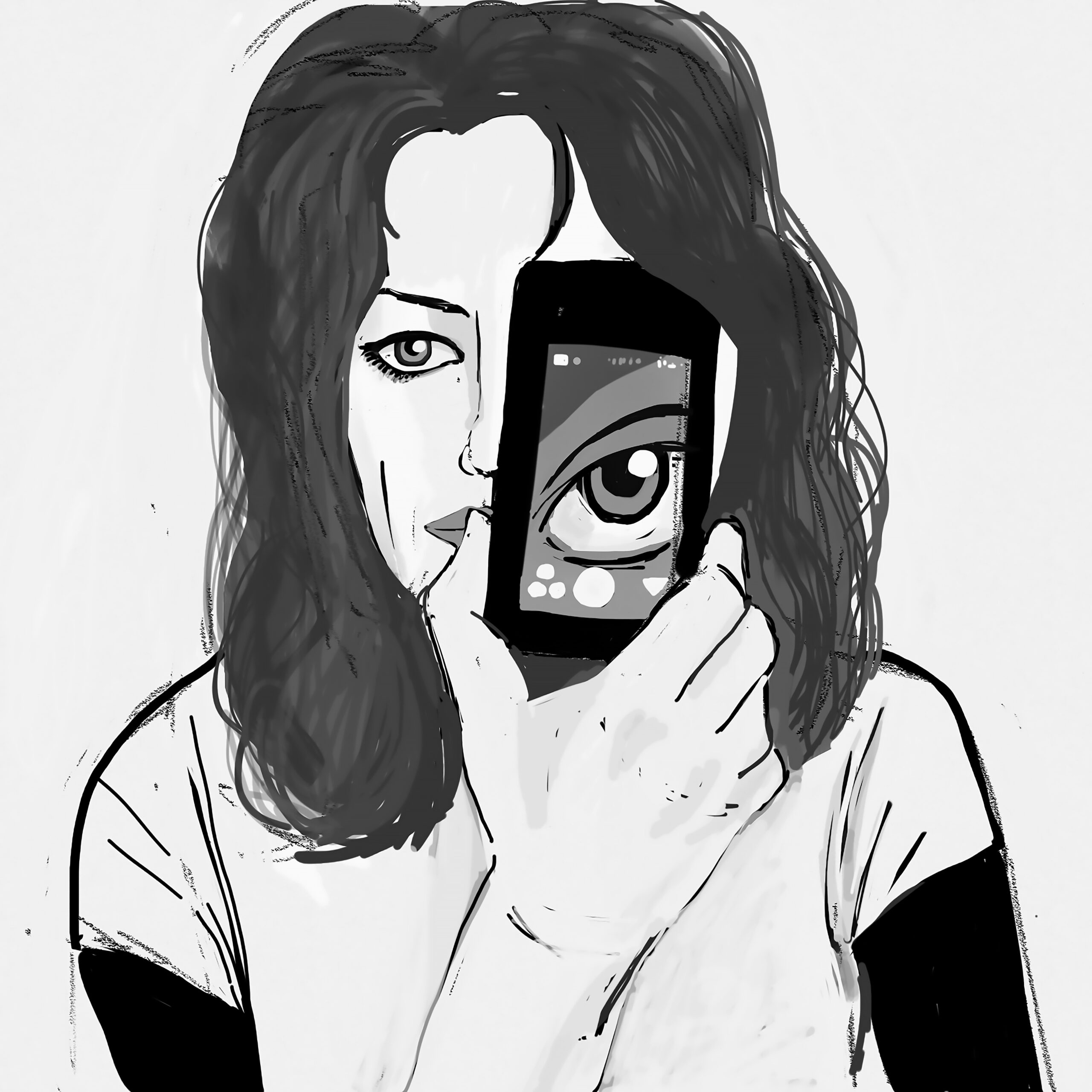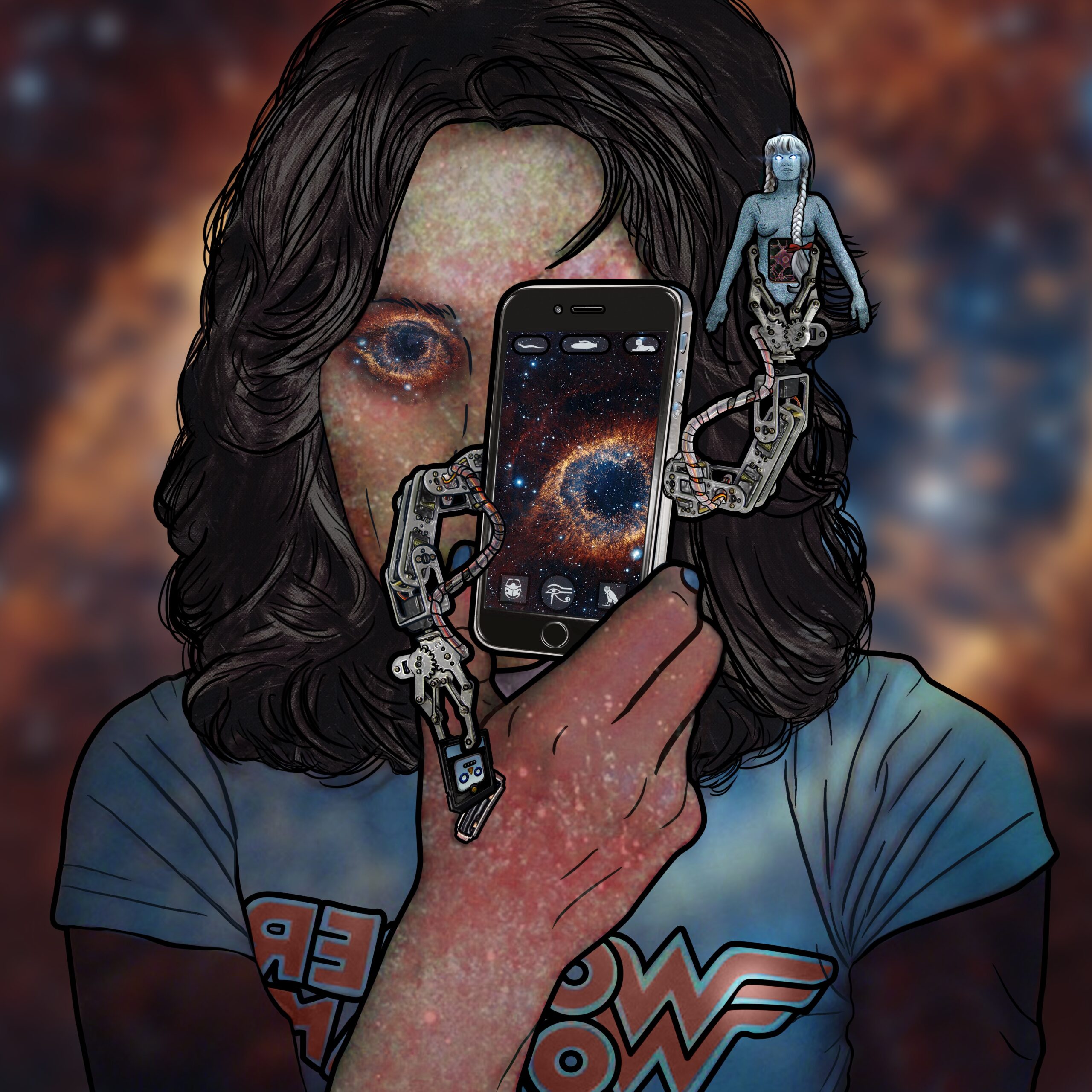Some Questions Surrounding Robots and Rivers
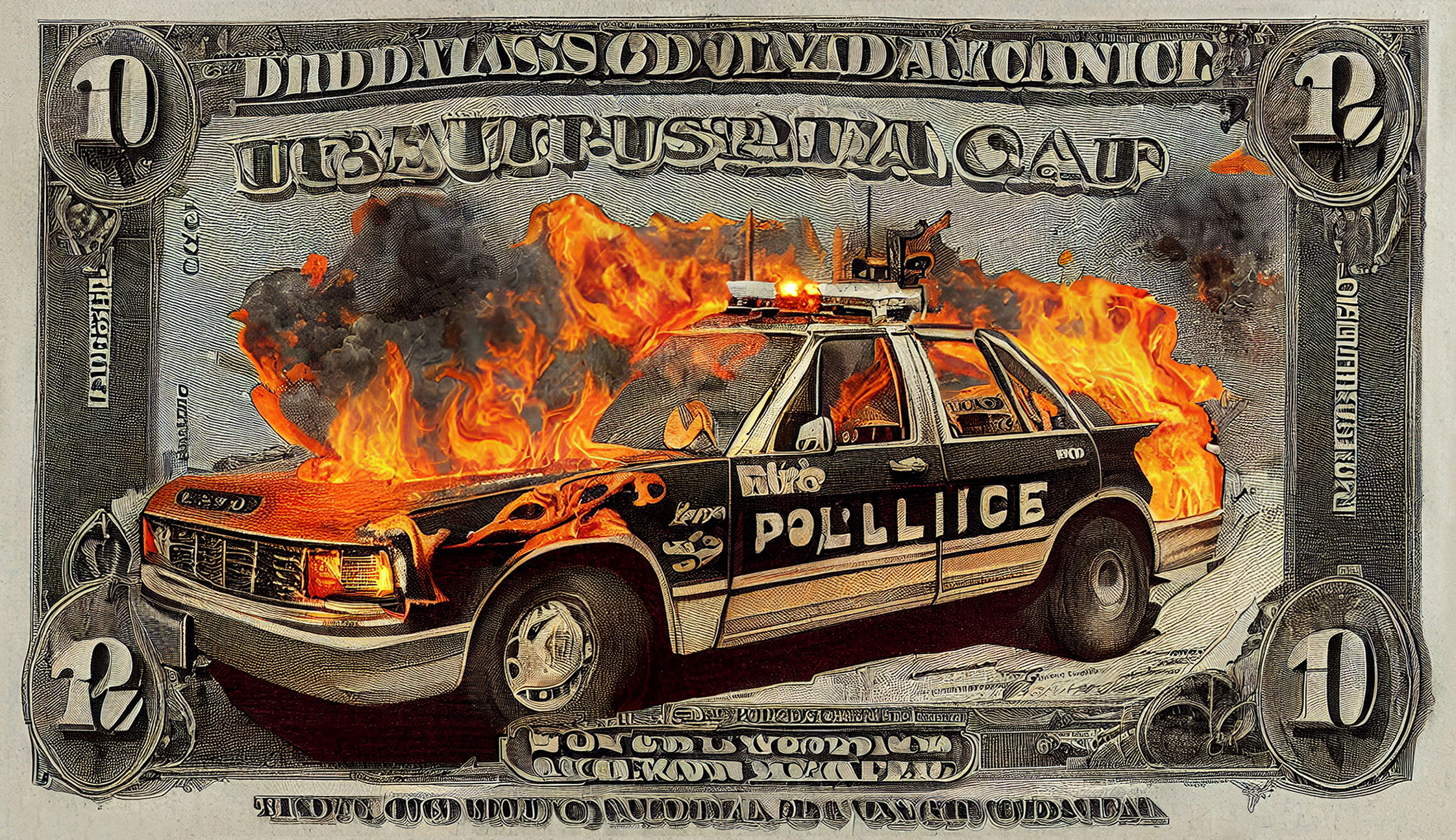
Aaron Huey, Currency of Protest (detail), 2022, seed paper and archival ink, 3.5 x 5.5” [courtesy of the artist, and Off Paradise Gallery, NY]
Share:
Media artist and theorist Mark Amerika engaged in a conversation with GPT-2 (generative pre-trained transformer)—an open-source language model released in February 2019 by OpenAI—with the aim of producing a symbiotic creative dialogue. He describes that experience in My Life as an Artificial Creative Intelligence (2022), which includes passages from the Talk to Transformer website. Amerika asked, “What is an artificial creative intelligence?” and received the response, “A human being who can think outside the box.” 1
The metaphor is a lovely one for an entity typically associated with the black-box obscurantism of surveillance capitalism. Being human, after all, entails a box of its own: the person. Creators of Western frameworks have debated, over the last two millennia, the legal and ethical standing of members of their own species.2 For the Ancient Greeks, personhood, in the form of citizenship, was tied to the right to own property, thus revealing the general establishment of agrilogistics—a set of ideologies derived from the Agricultural Revolution of twelve thousand years ago, whereby farming produced notions of private property and inheritance, trade and power, status and wealth.
Aaron Huey, Currency of Protest (detail), 2022, seed paper and archival ink, 3.5 x 5.5” [courtesy of the artist, and Off Paradise Gallery, NY]
By 1948, the Universal Declaration of Human Rights sought to make notions of equality ubiquitous, even if they were not then, or now, practiced everywhere. Neither do the ideas etched in the declaration recognize everyone; colonized and racialized peoples have historically been excluded from the category of the “human.” 3 The question of who gets to be a person remains fraught. As of 2010, the United States recognizes corporations as legal persons. In what is now called the United States, Native tribes such as the Yurok, in California, have granted rights of personhood to the Klamath River. In the last decade, nations ranging from India to Ecuador have granted rights to rivers. The meaning of personhood is not what it once was, and scholars debate the legal and ethical ramifications of this broadening spectrum.
Historian Michael Bess argues for expanding the legal notion of person through a “loose progression toward ever higher levels of capability and awareness.” 4 His speculation sits within the US legal framework, and retaining those judicial logics centers and reinforces sociopolitical notions of technology that generally treat it as if it were without specificity—as the anthropologist Genevieve Bell explains, “a set of implicit, tacit, cultural assumptions that are unvoiced” proliferates around AI. The assumption of AI’s unmarked status is made evident when the term gets marked with a descriptor, such as Buddhist AI or Indigenous AI. 5 But, wait: What is AI?
Aaron Huey, Currency of Protest (detail), 2022, seed paper and archival ink, 3.5 x 5.5” [courtesy of the artist, and Off Paradise Gallery, NY]
AI is a widely used term, yet its vagaries confound, even as feelings of anxiety, fear, and repulsion toward it imply a sense of knowing. Clichés of robot and computer regimes flow from Hollywood. Are we talking about autonomous vehicles, generative outputs, sensing systems, drones? Is my Google search a use of AI? News reports describe manipulative surveillance algorithms, even outright racist and sexist chat bots. These last entities are all too real, and they reflect the reality of our social and political choices. We blame machines to avoid our own culpability.
Apocalyptic fantasies of Artificial General Intelligence (AGI)—a term that forecasts an advanced machine with the same learning abilities as a normative human and therefore challenges human superiority—project a problem into the future while ignoring the supremacist systems rampant in our present. AI channels imagination toward a future, distracts from the past, and enables the current present. It reiterates, and even exacerbates, othering. It obfuscates the logics that create such thinking. It destroys the concept of genius, not by refuting notions of authorship, authenticity, and originality, but by interjecting doubt regarding the cultural ecologies that entrenched their unconditional value.
Aaron Huey, Currency of Protest (detail), 2022, seed paper and archival ink, 3.5 x 5.5” [courtesy of the artist, and Off Paradise Gallery, NY]
What is this AI, that has suddenly become not just a software but a subject acting upon us?
To say what, not who, while giving an object agency invokes the realm of confusion in our relations with so many machines: the car ran over a bird; drones destroyed another village; Google steals from us. Who is this us that is not a what?
Each “who” embedded in a social system, and acting out those ingrained ideologies, is also a “what.” AI typically means Artificial Intelligence. Some use the term augmented intelligence, not in the sense of “better than,” but “offering more than,” as in augmented reality. Political scientist Herbert Simon, in The Sciences of the Artificial (1996), distinguishes between natural and biological, artificial and synthetic. A corn field in Iowa is not a phenomenon of nature, though its products are biological. Colored glass made to look like a gem is artificial, but “a man-made gem chemically indistinguishable from sapphire would be called synthetic.” 6 Artificial emerges as a pretense, even a fraud, and its nomenclature expresses an anxiety over being lied to.
But who and what is lying to whom about what regarding AI? Perhaps AI’s deceptive register stems from technologists’ ignoring how it has been conjured from a very specific culture, country, and context. Indigenous scholarship around AI often highlights how Western notions of knowledge stem from value systems that enabled colonization and slavery. 7 Imagine, instead, as the Indigenous AI consortium writes in their Indigenous AI position paper, that knowledge could be “articulated as that which allows one to walk a good path through the territory.” 8
Aaron Huey, Currency of Protest (detail), 2022, seed paper and archival ink, 3.5 x 5.5” [courtesy of the artist, and Off Paradise Gallery, NY]
The Center on Privacy & Technology at Georgetown Law no longer uses the terms AI, artificial intelligence, or machine learning, because those terms “obfuscate, alienate and glamorize.” 9 The term artificial intelligence was coined at MIT, but researchers at Rand Carnegie Mellon University preferred “complex information processing.” 10 How much clearer that term might have been.
Distress over the auction house Christie’s selling an AI work by the collective Obvious in 2018 gained momentum in 2022, when Jason Allen won first prize at the Colorado State Fair for his submission that used AI. Advancements in image generation suggest an economically expeditious option for businesses and publishers that threatens the field of illustration. Less attention goes to how humans are still crucial to cultivating those images. Asked about her use of AI, photographer Laurie Simmons explained that her fluency with prompts was the secret to the success of her work.11
Aaron Huey, Currency of Protest (detail), 2022, seed paper and archival ink, 3.5 x 5.5” [courtesy of the artist, and Off Paradise Gallery, NY]
Most artists using image systems explain that the initial output is rarely sufficient. Artist Aaron Huey generated images of political activism that he then curated and produced into the semblance of fiat paper money for Currency of Protest (2022). Huey found the depictions of people produced by the text-to-image generators problematic and, unwilling to reiterate the prejudices of historic media content, he largely removed those images from the edition. The work mimics US currency, but it replaces the tightly controlled arrangement of monuments and white leaders with scenes of unrest—burning cars, demolished buildings, wire fencing, and barricades. These images are surrounded by the machine’s approximations of value signs and notations, which, when combined, designate each scrap of paper as a form of currency. The work surfaces connections between the economic order and revolutionary and militaristic movements. No despair, however, as one side of the bill shows wildflowers and grasses growing around this destruction. Finally, Huey printed the bills on seed paper, alluding to an activist phrase, “they tried to bury us; they didn’t know we were seeds.”
Huey invites audiences to take the works and plant them, thus giving art the opportunity to do generative work and resisting its dismissal as lacking “real world” impact. In this way, he marshals the machine to seed the land. Ironically, many prefer to keep the paper as art. What and whose values block transformative potential? Confronting my own hegemonic inculcation when I could not relinquish the work to the soil remains the uncomfortable challenge of Currency of Protest. Huey produces a complex project layered with associations that arise through his thoughtful engagement with AI.
Recently, artists have pointed to their works’ inclusion in image-generating data sets. Copyright is unlikely to defend against the mechanism of such machine models. Have large tech companies probably taken artists’ images as a part of training? Yes. But proving it was those stolen images in particular that enabled a specific output poses considerable challenges. Are we prepared to consider a radically new social, legal, political, and economic culture, given the advent of these technologies? Are we prepared to consider how they reflect problems within the operations of current systems of power? Are we prepared to question the society in which we are imbricated, the power structures that it, and we (always a who and a what), enable?
“The ideal of technology and automation should allow us to be more human and more expressive together, not replace us all together.” —Holly Herndon, tweet, November 26, 2019
Carla Gannis, Selfie Drawing 01, Jan 2015, 2015, digital drawing on iPad, Courtesy of the Artist
The anxiety of replacement is overwrought, but it instigates a rethinking of what “more human” might mean. The images produced by text-to-image systems are often impressive but, currently, they cannot produce simple diagrams, which require a combination of visual and verbal signs. Mimicking the line work of letters doesn’t require an understanding of them as anything more than objects, and such technologies cannot yet produce them meaningfully. Humans and machines do better together than either can alone in such games as chess or Go, or in surgery, or in accounting. Animals sense seismic activity before highly calibrated human technologies can. Being “more human” might mean less focus on legal personhood and more attention to ways of thinking that define the terms of human exceptionalism.
In 2015, artist Carla Gannis was already thinking about many of these issues. Trained as a painter before she turned to digital art, Gannis launched the yearlong series The Selfie Drawings to play with the questions of self-representation that a daily photography and drawing practice brought forth. The series doesn’t use AI beyond the various algorithms that support such software as Photoshop—an important reminder that these themes are not tied to specific media use.
The first work in the series shows a simple black-and-white image of Gannis from the waist up, her face partly obscured by a mobile device, an eye staring out from its screen. In the final one, Selfie Drawing 52, Powers of Ten, she is in full-spectrum color. On the screen of the mobile device covering her face is something resembling an eye, but it is the Helix Nebula, affectionately known as the Eye of God—introducing the delusions of grandeur prevalent across tech-utopianism and anthropocentrism. Yet the image paints a different picture. From the sides of the device stretch robotic arms, one of which holds up a blue avatar with glowing eyes. The device is supported by her hand, providing a platform for a tiny figure coming from the machine to work. An arc of light across her chest reminds us that this whole cluster is still contained within a star-studded universe, of which we are but one radiating element.
Carla Gannis, Selfie Drawing 52, Powers of Ten, Dec 2015, digital drawing and colored pencil, Courtesy of the Artist
Through the title of this final image, Gannis references the Eames film Powers of Ten (1977), which presents the universe and an atom through exponential shifts of ten, starting with human size. Or, as the narrator remarks: “the scale we know best, our own.” 12 The term Anthropocene coheres discussions about the narcissistic tendency that marks Western societies, though it specifically refers to the appearance of cement, plastics, and other synthetic products on the earth’s crust. Historical timelines of Western epistemologies typically begin with human markings. Emphasizing cultural production of homo sapiens—meaning “wise human”—ignores the networks of droughts, storms, rivers, plants, and animals that contributed to human migrations, relations, and cultivations which brought us where we are today. Intelligence doesn’t seem like the most appealing referent for self-definition anymore. Some sciences suggest other qualities for human self-definition, and societies around the world present others, but the social systems that issue many technologies remain tied to the concept of intelligence.
Quickness was a synonym of intelligence at one point. But is speed of understanding a measure to retain? Could these new technologies offer more than the rapid churn of information processing? Might AI systems challenge the hierarchical models that produced them, necessitating alternative relational—not just rational—covenants?
Could artificial creativity help us see, and therefore think, beyond the box of our own human exceptionalism veiled by the fears projected onto others?
Will we try?
Charlotte Kent, PhD is assistant professor of visual culture at Montclair State University and an arts writer. Writing for numerous magazines and journals, she is an editor at large for The Brooklyn Rail, and is co-editor (with Katherine Guinness) of Contemporary Absurdities, Existential Crises, and Visual Art (forthcoming, Intellect Books). She is a graduate of the CUNY Graduate Center, St. John’s College, Phillips Academy Andover, and The Writers Institute.
References
| ↑1 | Mark Amerika, My Life as an Artificial Creative Intelligence, (Redwood City, CA: Stanford University Press, 2022), 19. |
|---|---|
| ↑2 | 2 Michael Bess, “Eight Kinds of Critters: A Moral Taxonomy for the Twenty-Second Century,” The Journal of Medicine and Philosophy 43, no. 5 (September 5, 2018): 585–612, 586. |
| ↑3 | 3 Sylvia Wynter, “‘No Humans Involved’: An Open Letter to My Colleagues,” Forum N.H.I.: Knowledge for the 21st Century 1, no. 1 (Fall 1994): 1–17. |
| ↑4 | 4 Bess, “Eight Kinds of Critters,” 595. |
| ↑5 | 5 Genevieve Bell, “Putting AI in Its Place: Why Culture, Context, and Country Still Matter,” AI Now 2017 Public Symposium, July 10, 2017, video, online. |
| ↑6 | 6 Herbert A. Simon, The Sciences of the Artificial (Cambridge, MA: MIT Press, 2008), 4 |
| ↑7 | 7 Jason Edward Lewis et al., “Making Kin with the Machines,” Journal of Design and Science, July 16, 2018, online; “Indigenous Protocol and Artificial Intelligence Position Paper,” ed. Jason Edward Lewis, Aboriginal Territories in Cyberspace, 2010, online; Amelia Winger-Bearskin, “Antecedent Technology,” Immerse, November 21, 2019, online. |
| ↑8 | 8 Lewis et al., “Making Kin” |
| ↑9 | 9 Emily Tucker, “Artifice and Intelligence,” Tech Policy Press, March 17, 2022, online. |
| ↑10 | 10 Simon, Sciences of the Artificial, 4. |
| ↑11 | 11 “Laurie Simmons and Chloe Wise in Conversation,” New York Academy of Arts, New York, NY, January 11, 2023. |
| ↑12 | 12 Powers of Ten: A Film Dealing with the Relative Size of Things in the Universe and the Effect of Adding Another Zero, directed by Charles and Ray Eames (IBM and Pyramid Films, 1977). |
